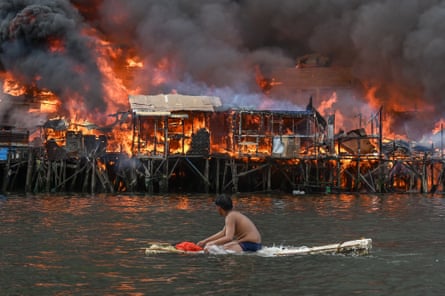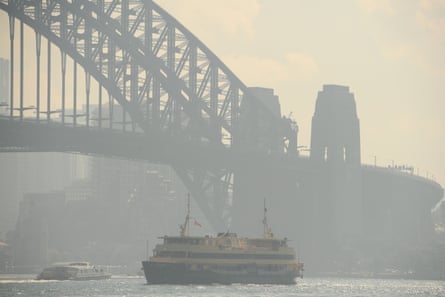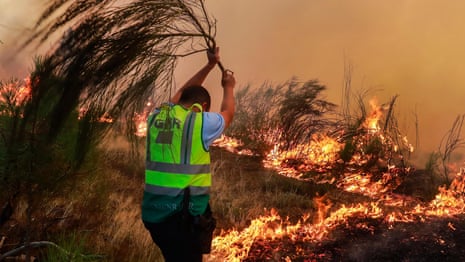The main purpose of this ongoing blog will be to track planetary extreme, or record temperatures related to climate change. Any reports I see of ETs will be listed below the main topic of the day. I’ll refer to extreme or record temperatures as ETs (not extraterrestrials).😜
Main Topic: Wildfires Are Getting Deadlier and Costing More. Experts Warn They’re Becoming Unstoppable
Dear Diary. The United States is getting off relatively light this year as far as major climate change driven disasters go. We have yet to witness a major hurricane landfall like Helene from 2024. There have been western wildfires, but none have made big news. Yet 2025 overseas news can’t put any of us at ease.
The Mediterranean has seen more than its fair share of heatwaves leading to wildfires during 2025. This fire weather just adds to statistics indicating that wildfires are increasingly as the planet warms. Here are more details from the Guardian:
Wildfires are getting deadlier and costing more. Experts warn they’re becoming unstoppable
Of 200 fires in the past 44 years, half of the fires that cost US$1bn or more were in the last decade

A helicopter drops water on a wildfire in Los Angeles in January 2025. For the first time scientists say they have shown unambiguously that the numbers of ‘societally disastrous’ wildfires have increased around the world. Photograph: Ethan Swope/AP
Wildfires are getting deadlier and costing more. Experts warn they’re becoming unstoppable
Of 200 fires in the past 44 years, half of the fires that cost US$1bn or more were in the last decade
Graham Readfearn Environment and climate correspondent
Thu 2 Oct 2025
Wildfires tore through central Chile last year, killing 133 people. In California, 18,000 buildings were destroyed in 2018 causing US$16bn (A$24bn, £12bn) in damage. Portugal, Greece, Algeria and Australia have all felt the grief and the economic pain in recent years.
As the headlines, the death tolls and the billion-dollar losses from wildfires have stacked up around the world, so too have the rising temperatures – fuelled by the climate crisis – that create tinderbox conditions.
Australia’s horrifying climate future in four charts – and how we can avoid the worstRead more
For the first time scientists say they have shown unambiguously that the numbers of “societally disastrous” wildfires – the ones that hit economies hard and take lives – have increased around the world as global heating bites.
“We’re witnessing a fundamental shift in how wildfires impact society,” said the Australian scientist Dr Calum Cunningham, who led research published in the journal Science. “Climate change sets the stage for these disasters.”
Looking at the 200 costliest fires between 1980 and 2023 – pulled from a private database maintained by global re-insurer Munich Re – the trends were clear.

Of the 200 most damaging fires since 1980 – that is, the fires with the highest direct costs relative to each nation’s GDP – 43% happened in the last 10 years.
Half of the fires that cost US$1bn or more were also in the last 10 years. Over the 44 years analysed, the frequency of fires causing 10 or more deaths tripled while the population only went up by 1.8 times.
Temperatures and the dryness of the atmosphere and of the vegetation – all factors promoting fires – all got significantly worse between 1980 and 2023.
Half the wildfires happened while local weather conditions were in the worst 0.1% on record for fire danger.
Disturbing regularity
Many studies have found the weather conditions that promote fires around the world are getting worse, and happening more often, because of global heating.
But the last major study that looked globally at the cost of those wildfires and the deaths related to them was in 2016 and found no trends.
The period since then had been “punctuated by major fire disasters with disturbing regularity,” the authors said.
“We went looking for that study showing things were getting worse. We felt intuitively that they were, but there was no research,” said Cunningham, of the University of Tasmania’s Fire Centre.
“Climate sceptics have seized on that gap, so we hope this puts to bed the idea it’s not getting worse. Things are getting worse.
“It is unambiguous and it is clear climate change is playing a role. These aren’t just bigger fires, they’re fires occurring under increasingly extreme weather conditions that make them unstoppable.”

He said the results point to the need to cut greenhouse gas emissions quickly, but to also better manage forests close to populations. The public could help by doing maintenance to stop embers getting inside buildings and clearing fuels like leaves.
Other unquantified influences that may be contributing to the worsening trend included the numbers of people living close to forests and the abandonment of agricultural areas.
The authors said the trends came despite “ballooning expenditure on fire suppression” – US federal spending on fire suppression, for example, more than tripled between 1985 and 2022.
“This expenditure is likely limiting (or masking) the fire crisis, but not offsetting it,” they wrote.

The number of deaths from fires was likely a gross underestimate. One database recorded 19 direct deaths from fires in Indonesia in 2015, but the resulting air pollution was implicated in about 100,000 premature deaths from respiratory problems.
Roadmap to catastrophic disaster
When the researchers looked at areas with a high risk of fires close to populations, they found this deadly combination on 10% of the planet’s land surface.
Those areas included January’s fires in Los Angeles, with direct losses estimated at US$65bn – “likely the costliest fire disaster in history” – and the 2024 fires in Valparaíso, Chile, that claimed 135 lives.
Both those disasters happened after the data analysis was completed, suggesting the methods were able to predict places at risk.
“This provides a roadmap for where the next catastrophic disasters are most likely to occur,” said Bowman.
Dr Hamish Clarke, an expert on fires and climate change at the University of Melbourne not involved in the study, said: “This is an important new paper that puts some hard numbers on a much discussed topic – global trends in, and drivers, of socially and economically damaging fires.
“Unfortunately the news is not good – fires are killing more people and imposing more costs on economies around the world.”
Explore more on these topics
Here are more “ETs” recorded from around the planet the last couple of days, their consequences, and some extreme temperature outlooks, as well as any extreme precipitation reports:
Here is More Climate News from Monday:
(As usual, this will be a fluid post in which more information gets added during the day as it crosses my radar, crediting all who have put it on-line. Items will be archived on this site for posterity. In most instances click on the pictures of each tweet to see each article. The most noteworthy items will be listed first.)